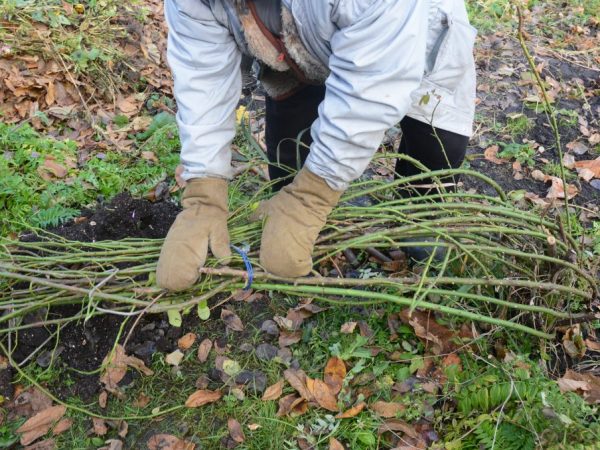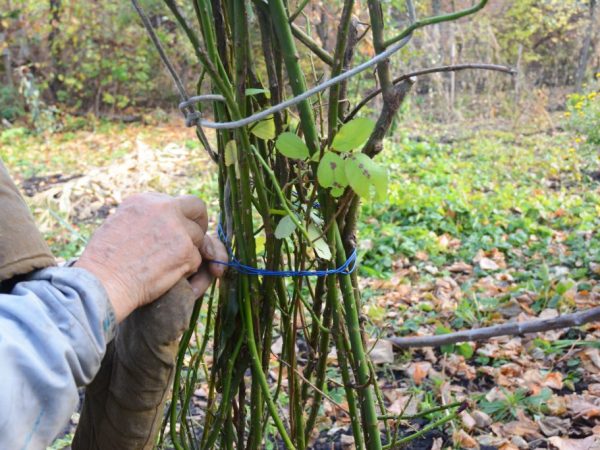We cover roses for the winter in the Urals - terms and rules
Delicate roses require constant care. Until some time in the Urals, very few people risked planting these flowers, fearing harsh winters and sudden changes in temperature. With the advent of winter-hardy varieties, everything has changed, but care must still comply with all the rules. Consider how to cover roses for the winter so that the bushes can withstand severe frosts well.

We cover roses for the winter in the Urals - terms and rules
Winter hardy varieties
In order not to be disappointed in planting and growing roses, you should carefully choose a variety. The zoned species grown in local nurseries show particular resistance to the vagaries of nature.
They are adapted to the climate, easily tolerate short-term frosts down to -5 °, are resistant to strong winds and are accustomed to the composition of the soil characteristic of most regions of the Urals.
These varieties include:
- John Cabot;
- Quadra;
- Golden Celebration;
- Ashram;
- Double Delight;
- American Pride;
- Arthur Bell;
- Jack Frost;
- Deja vu;
- Mont Blanc;
- Lavinia;
- Gloria Day.
It is worth considering: Canadian varieties are more resistant to the Ural climate, since they were bred in similar conditions.
Optimal timing
In the Urals, preparations for winter begin in mid-August, they are carried out in stages.
From the moment when the thermometer drops to -5 at night, you can begin to wrap the roses in order to preserve them in winter. The approximate time is mid-October.
Important: every year the weather is slightly different from the previous one, so it will not be possible to name the exact time for hiding roses. It is necessary to focus on the average daily temperature for 3-5 days.
The climatic features are such that often frost occurs, and the snow cover does not fall for a long time. During this period, the root system of the bushes may suffer, so you should not wait for snow.
But it is also impossible to cover too early, otherwise the roots will begin to grow and all the prerequisites for fungal diseases will appear.
Preparing for shelter
In order for the plant to successfully overwinter, they begin to prepare it for the cold in August.
Step-by-step instructions allow you to create optimal conditions for a long dormant period in the fall and a quick start to growth in the spring.
- At the end of August, the lower layer of leaves is removed without affecting the tops. All collected material is carefully collected and incinerated. The trunk circle is cleaned and loosening is carried out.
- Before the long cold winter, it is necessary to create a supply of nutrients in the plant, for which potash and phosphorus fertilizers are applied. Avoid nitrogen fertilizing - they provoke a rapid growth of green mass, which is harmful for roses at the end of summer. They are reserved for spring and awakening.
- Preventive spraying with Bordeaux liquid is done in September. This ensures that spores and molds that may have lurked in damp ground and on the lower leaves are eliminated.
- Mulching is required to lignify the main stems. Sawdust, peat, crushed bark, pine shavings are used.All wet material, such as leaves, small weeds, humus in the fall from under the bushes is removed, replacing it with winter mulch.
Final pruning is in October. The weaving species do not touch, for the rest, the shoots are shortened to half a meter.

Roses begin to prepare for winter at the end of summer.
There is a difference of opinion regarding minor young shoots:
- Some gardeners recommend removing them so as not to pull the juices;
- Others see them as a spring replacement for damaged parts.
Full cover of roses is carried out when at night the temperature drops to -5 degrees for several days.
Shelter options and rules
The method of winter plant protection is chosen depending on the species: for weaving and liana-like varieties, it will be one, and for upright roses it will be completely different.
Preference is given to waterproof materials in combination with insulation, you can use a frame structure or wrap the branches with foil, securing it with twine or adhesive tape.
Powder
In the conditions of the Urals, it is not effective and is used only as an additional measure of protection.
Snow can not wait until the middle of winter and then the defenseless bushes will simply freeze out, never seeing the snow blanket. It is much safer to throw it onto a ready-made shelter.
The snowdrift is removed with the first thaw so that it does not create a greenhouse effect.
Frame method
Fully meets the requirements of the Ural region.
There is enough air under such a structure, heat is retained and moisture does not penetrate. The plant is reliably protected from frost, wind and sudden changes in temperature. The flowering buds are not damaged, the optimum level of humidity is kept.
The shelter is built on the basis of a rectangular frame made of boards or boxes and a covering film. For extended plantings, it is convenient to use arcs by analogy with spring greenhouses.
Technology:
- the frame is installed;
- covered with a non-woven material that retains heat;
- a waterproof film is stretched from above;
- the structure along the edges is fixed with pegs or bricks to avoid winding the film.
Interesting: under a single shelter, designed for several bushes, roses winter better.
Frameless way
Suitable for liana-like and weaving varieties, as well as for tall species that do not tolerate large-scale pruning.
To keep the delicate tips of the shoots from freezing, you will have to devote much more time to them. Material consumption will also be more significant.
First, cut out old and dried branches, carefully remove the root zone. If the shoots are bent, then they are laid on the ground, warming with lutrasil or spunbond, then covered with a film and fixed with twine.
For species that do not have flexibility, you will have to form several separate bundles, cover with insulation, and then with a film, fixing with adhesive tape or linen cord.
Useful Tips
- The most functional shelter, consisting of several layers of insulation, a waterproof film and a garbage bag put on top.
- The frame version is more suitable for vertical bushes, weaving are laid on the ground.
- Sprinkling snow on it increases the rose's chances of survival. In the spring, the snowdrift is removed first so as not to overmoisten the soil at the roots.
- Closer to October, watering and feeding are stopped, which creates a dormant regime.
- For planting, it is better to take frost-resistant varieties, zoned for the Urals and Siberia.
- A dry sunny day is chosen for shelter, and the bushes are opened only in cloudy weather to avoid burns.
- During the spring thaw, the snow is removed first, then the waterproof film is removed to ensure air circulation.
- A layer of mulch is removed from the roots only when a stable above-zero temperature occurs.
Roses properly prepared for winter will easily survive even the harsh Ural frosts and in spring they will quickly grow, forming a large number of buds to the delight of the owner of the rose garden.

